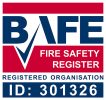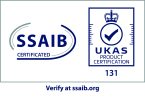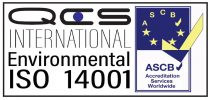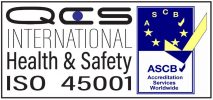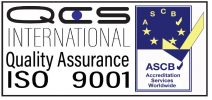A Brief History
The world’s first recognisable sprinkler system was installed in the Theatre Royal, Drury Lane in the United Kingdom in 1812 by its architect. The system was designed by William Congreve was covered by patent No 3606 dated the same year.
The apparatus consisted of a cylindrical airtight reservoir of 95,000 litres fed by a 10-inch (250 mm) water main which branched to all parts of the theatre. A series of smaller pipes feed from the distribution pipe, these were pierced with a series of 1⁄2-inch (13 mm) holes that pour water in the event of a fire.
From 1852 to 1885, perforated pipe systems were used in textile mills throughout New England as a means of fire protection. However, they were not automatic systems; they did not turn on by themselves. Inventors first began experimenting with automatic sprinklers around 1860. The first automatic sprinkler system was patented by in America by Philip W. Pratt of in 1872.
In 1890 Frederick Grinnell improved the design further and invented the glass disc sprinkler, essentially the same as that in use today
Usage
Sprinklers have been in use since 1874 and were used in factory applications where fires at the turn of the century were often catastrophic in terms of both human and property losses.
Sprinklers may be required to be installed by building codes or may be recommended by insurance companies to reduce potential property losses or business interruption.
European regulations
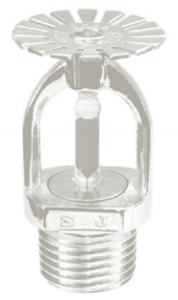





In schools, for example, the government has issued recommendations through Building Bulletin 100 that most new schools should be constructed with sprinkler protection.
In 2011 Wales became the first country in the world where sprinklers are compulsory in all new homes. The law will apply to
newly built houses and blocks of flats, as well as care homes and university halls of residence.
In Scotland, all new schools are sprinklered, as are new care homes, sheltered housing and high rise flats.
Most European countries also require sprinklers in shopping centres, in large warehouses and in high-rise buildings
Operation
Each closed-head sprinkler is held closed by either a heat-sensitive glass bulb or a two-part metal link held together with fusible alloy. The glass bulb or link applies pressure to a pip cap which acts as a plug which prevents water from flowing until the ambient temperature around the sprinkler reaches the activation temperature of the individual sprinkler head.
In a standard wet-pipe sprinkler system, each sprinkler activates independently when the predetermined heat level is reached. Because of this, the number of sprinklers that activate is limited to those near the fire (in reality, normally one or two will activate), thereby maximizing the available water pressure over the point of fire origin. This also minimizes the water damage to the building.
Sprinkler activation will do less damage than a firefighters hose stream, which provides approximately 15 litres a second (900Ltr/Min). In contrast, a typical sprinkler used for industrial premises discharge around 2.5 Litres a second (Up to 150 litres/min).
Wet pipe systems
By a wide margin, wet pipe sprinkler systems are installed more often than all other types of fire sprinkler systems. They also are the most reliable, because they are simple, with the only operating components being the automatic sprinklers and (commonly, but not always) the automatic alarm check valve. An automatic water supply provides water under pressure to the system piping.
Dry pipe systems






Dry pipe systems are most often used in unheated buildings, parking garages, or in refrigerated coolers.
Operation – Water is not present in the piping until the system operates. The piping is filled with air below the water supply pressure.
When one or more of the automatic sprinklers is exposed, for a sufficient time, to a temperature at or above the temperature rating, it activates and opens, allowing the air in the piping to vent from that sprinkler and releasing water. Each sprinkler operates individually.
Some property owners and building occupants may view dry pipe sprinklers as advantageous for the protection of valuable collections and other water sensitive areas. This perceived benefit is due to a fear that wet system piping may slowly leak water without attracting
Disadvantages of using dry pipe fire sprinkler systems include
• Increased complexity – Dry pipe systems require additional control equipment and air pressure supply components which increases system complexity.
• Higher installation and maintenance costs – The added complexity impact the overall dry-pipe installation cost, and increases maintenance expenditure primarily due to added service labour costs.
• Lower design flexibility – Regulatory requirements limit the maximum permitted size (i.e., 750 gallons) of individual dry-pipe systems unless additional components and design efforts are provided to limit the time from sprinkler activation to water discharge to less than one minute. These limitations may increase the number of individual sprinkler zones (i.e., served from a single riser) that must be provided in the building, and impact the ability of an owner to make system additions.
• Increased fire response time – Because the piping is empty at the time the sprinkler operates, there is an inherent time delay in delivering water to the sprinklers which have operated while the water travels from the riser to the sprinkler, partially filling the piping in the process. A maximum of 60 seconds is normally allowed by regulatory requirements from the time a single sprinkler opens until water is discharged onto the fire. This delay in fire suppression results in a larger fire prior to control, increasing property damage.
• Increased corrosion potential – Following operation or testing, dry-pipe sprinkler system piping is drained, but residual water collects in piping low spots, and moisture is also retained in the atmosphere within the piping. This moisture, coupled with the oxygen available in the compressed air in the piping, increases pipe internal wall corrosion rates, possibly eventually leading to leaks. The internal pipe wall corrosion rate in wet pipe systems (in which the piping is constantly full of water) is much lower, as the amount of oxygen available for the corrosion process is lower.
• Corrosion can be combated by using galvanized steel pipe which is less susceptible to corrosion, or by using dry nitrogen to pressurize the system, rather than air. These additional precautions will increase the cost of the system, but can help prevent system failure and premature need for system replacement in the future.
Deluge systems






Water is not present in the piping until the system operates. Because the sprinkler orifices are open, the piping is at atmospheric pressure. To prevent the water supply pressure from forcing water into the piping, a deluge valve is used in the water supply connection, which is a mechanically latched valve. It is a non-resetting valve, and stays open once tripped.
Pre-action systems
Pre-action sprinkler systems are specialized for use in locations where accidental activation is undesired, such as in museums with rare art works, manuscripts, or books; and Data Centres, for protection of computer equipment from accidental water discharge.
Pre-action systems are hybrids of wet, dry, and deluge systems, depending on the exact system goal. There are two main sub-types of pre-action systems: single interlock, and double interlock.
The operation of single interlock systems are similar to dry systems except that these systems require that a “preceding” fire detection event, typically the activation of a heat or smoke detector, takes place prior to the “action” of water introduction into the system’s piping by opening the pre-action valve, which is a mechanically latched valve (i.e., similar to a deluge valve).
In this way, the system is essentially converted from a dry system into a wet system. The intent is to reduce the undesirable time delay of water delivery to sprinklers that is inherent in dry systems. Prior to fire detection, if the sprinkler operates, or the piping system develops a leak, loss of air pressure in the piping will activate a trouble alarm. In this case, the pre-action valve will not open due to loss of supervisory pressure, and water will not enter the piping.
The operation of double interlock systems are similar to deluge systems except that automatic sprinklers are used. These systems require that both a “preceding” fire detection event, typically the activation of a heat or smoke detector, and an automatic sprinkler operation take place prior to the “action” of water introduction into the system’s piping.
Activation of either the fire detectors alone, or sprinklers alone, without the concurrent operation of the other, will not allow water to enter the piping. Because water does not enter the piping until a sprinkler operates, double interlock systems are considered as dry systems in terms of water delivery times, and similarly require a larger design area.
Foam water sprinkler systems
A foam water fire sprinkler system is a special application system, discharging a mixture of water and low expansion foam concentrate, resulting in a foam spray from the sprinkler. These systems are usually used with special hazards occupancies associated with high challenge fires, such as flammable liquids, and airport hangars. Operation is as described above, depending on the system type into which the foam is injected.
Water spray
“Water spray” systems are operationally identical to a deluge system, but the piping and discharge nozzle spray patterns are designed to protect a uniquely configured hazard, usually being three-dimensional components or equipment (i.e., as opposed to a deluge system, which is designed to cover the horizontal floor area of a room). The nozzles used may not be listed fire sprinklers, and are usually selected for a specific spray pattern to conform to the three-dimensional nature of the hazard (e.g., typical spray patterns being oval, fan, full circle, narrow jet). Examples of hazards protected by water spray systems are electrical transformers containing oil for cooling or turbo-generator bearings. Water spray systems can also be used externally on the surfaces of tanks containing flammable liquids or gases (such as hydrogen). Here the water spray is intended to cool the tank and its contents to prevent tank rupture/explosion (BLEVE) and fire spread.
Water mist systems
Water mist systems are used for special applications in which it is decided that creating a heat absorbent vapour is the primary objective. This type of system is typically used where water damage may be a concern, or where water supplies are limited. NFPA 750 defines water mist as a water spray with a droplet size of “less than 1000 microns at the minimum operation pressure of the discharge nozzle.
The droplet size can be controlled by the adjusting discharge pressure through a nozzle of a fixed orifice size. By creating a mist and equal volume of water will create a larger total surface area exposed to the fire. The larger total surface area better facilitates the transfer of heat, allowing more water droplets to turn to steam more quickly. Steam, which absorbs more heat than water then reduces the temperature of the flame.
Operation – Water mist systems can operate with the same functionality as deluge, wet pipe, dry pipe, or preaction systems. The difference is that a water mist system uses a compressed gas as an atomizing medium, which is pumped through the sprinkler pipe. Instead of compressed gas, some systems use a high-pressure pump to pressurize the water so it atomizes as it exits the sprinkler nozzle. Systems can be applied using local application method or total flooding method, similar to Clean Agent Fire Protection Systems.
Design
Sprinkler systems are intended to either control the fire or to suppress the fire.
Control mode sprinklers are intended to control the heat release rate of the fire to prevent building structure collapse, and pre-wet the surrounding combustibles to prevent fire spread. The fire is not extinguished until the burning combustibles are exhausted or manual extinguishment is effected by firefighters.
Suppression mode sprinklers (formerly known as Early Suppression Fast Response (ESFR) sprinklers) are intended to result in a severe sudden reduction of the heat release rate of the fire, followed quickly by complete extinguishment, prior to manual intervention.






Usually, buildings are classified as:
• Light hazard
• Ordinary hazard group 1
• Ordinary hazard group 2
• Extra hazard group 1
• Extra hazard group 2.
After determining the hazard classification, a design area and density can be determined by referencing tables in the National Fire Protection Association (NFPA) standards.
The design area is a theoretical area of the building representing the worst-case area where a fire could burn. The design density is a measurement of how much water per square foot of floor area should be applied to the design area.
After the design area and density have been determined, calculations are performed to prove that the system can deliver the required amount of water over the required design area. These calculations account for all of the pressure that is lost or gained between the water supply source and the sprinklers that would operate in the design area.
This includes pressure losses due to friction inside the piping and losses or gains due to elevation differences between the source and the discharging sprinklers. Sometimes momentum pressure from water velocity inside the piping is also calculated.






Sprinkler systems in residential structures are becoming more common as the cost of such systems becomes more practical and the benefits become more obvious. Residential sprinkler systems usually fall under a residential classification separate from the commercial classifications mentioned above. A commercial sprinkler system is designed to protect the structure and the occupants from a
fire.
Most residential sprinkler systems are primarily designed to suppress a fire in such a way to allow for the safe escape of
the building occupants. While these systems will often also protect the structure from major fire damage, this is a secondary consideration. In residential structures sprinklers are often omitted from closets, bathrooms, balconies, garages and attics because a fire in these areas would not usually impact the occupant’s escape route.
If water damage or water volume is of particular concern, a technique called Water Mist Fire Suppression may be an alternative. This technology has been under development for over 50 years. It hasn’t entered general use, but is gaining some acceptance on ships and in a few residential applications. Mist suppression systems work by using the heat of the fire to ‘flash’ the water mist cloud to steam. This then smothers the fire.
Should you have any further questions relating to any of the above, please call 0117 958 38 38 (Option 1)
You will be put you through to our dedicated sprinkler team who will be happy to help


